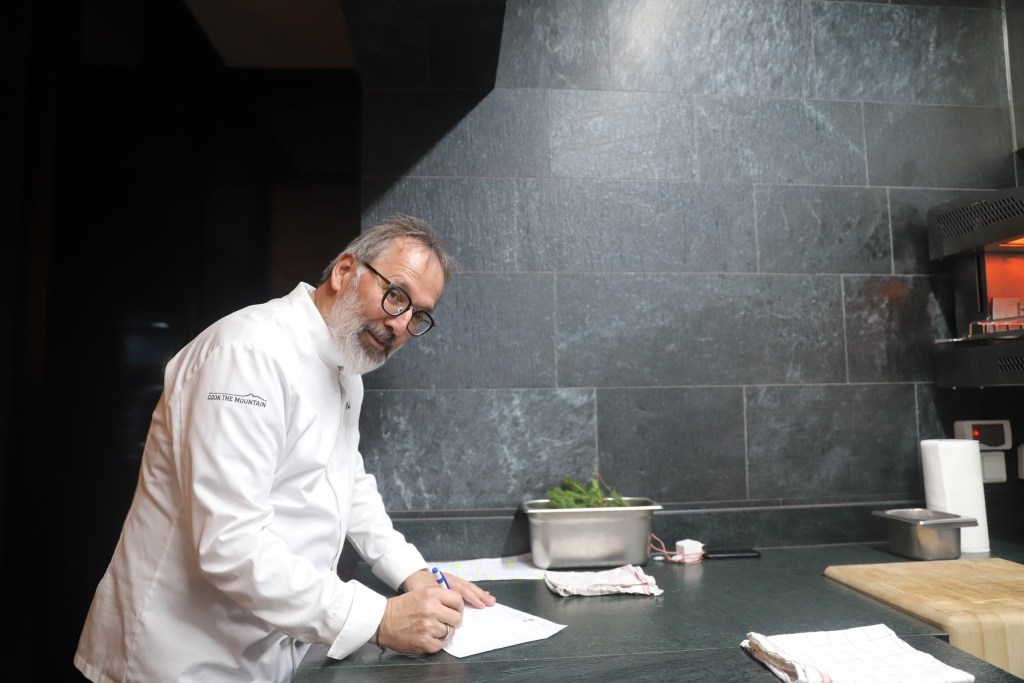
BRUNICO: On the outskirts of the buzzing small town of Brunico, in South Tyriol, 2,300 metres above sea level lies a stunning restaurant, AlpiNN which is Norbert Niederkofler’s second restaurant in the region.
The Italian chef rose to fame for his restaurant St Hubertus, which entered the 3 Michelin star hall of fame in 2017. At Alpinn, he has taken the Cook the Mountain philosophy not just in his cooking but also in the way that the restaurant has been designed.
Together with Mexican chef Jorge Vallejo of restaurant Quintonil, Norbert Niederkofler and his team organised a unique four hands dinner in this incredible location. This was the first such even which will see other internationally renowned chefs visit the mountain restaurant.
Together, the two chefs created a harmonious menu that respected the region and its produce.

The Mexican chef, together with his assistant Eliana, got some ingredients specifically from Mexico. One was the mole of San Pedro Atocpan which they served with wild mushrooms and the other was ‘cocopaches’ or beetles.
Jorge Vallejo of Quintonil restaurant, considered to be one of the top restaurants in the world, is one of the chefs to emerge after his experience at Enrique Olvera’s Puyol. He runs the restaurant together with his wife Alejandra Flores. They focus on vegetables and greens which are picked from a nearby garden. He and his team keep their carbon footprint low with most of the ingredients they use travelling less than 100 metres away.
Silence fell in the dining room when Jorge showed the actual ‘beetles’ that composed the cause which was served together with grilled beef. The guests at the restaurant had heard the word cocopaches in the description but little did they know that they were about to eat beetles that looked like a cockroach. But the cocopache is a kind of beetle that has existed for 300 million years and lives of mesquite trees. It has analgesic and anesthetic properties as well as a high content of proteins and amino acids. This beetle has been consumed since the pre-hispanic era mostly in Puebla and Hidalgo and is eaten with salt and lime, in tacos and sauces,

Jorge Vallejo 
Grilled beef 
Cocopaches
Each of the dishes at the dinner represented the mountains which is the philosophy used in the kitchen at AlpiNN and St Hubertus. The normal menu is based on seasonal and regional products with waste being cut to a minimum. Even bottled water is not transported up to the restaurant. Chef Niederkofler sees no point in transporting thousands of bottles by cable car only to have to bring down the bottles again. Instead he uses filtered water.

Smoked trout ‘ceviche’ 
After the aperitivo served in the foyer of the LUMEN museum which is next to the restaurant, Jorge Vallejo presented his first dish, smoked trout with yuzu, infused oil with mustard seeds, brassica and horse radish and an emulsion of oyster and herbs. The Mexican chef made a ceviche which did not use chili water but mustard seeds, horse radish and brassica to replace the chili and give the necessary spiciness to the dish.


Eel Japanese style 
Barley
Norbert Niederkofler, influenced by Japan served fresh water eel that was influenced from his trips to Japan. He glazed it with soda sauce that he made from mountain lentils and used the rest of the eel to make a stock and serve it as a ‘tea’.

Jorge Vallejo than served an atocpan style mole with a selection of wild mushrooms in an emulsion of butter and verbena which was accompanied by a mole and golden raison bread that resembled a panettone.
Atocpan means fertile land in ‘nahuatl’. It is the mole that best represents Mexico city. This mole was first created more than 50 years ago. at first, it was a mix of different moles like poblano, green and other ‘adobos’ but shortly after, it developed its own characteristics and became one of a kind. The mole is made with ‘chile mulato’ ‘chile ancho’ and chile pasilla, chocolate, seeds, fruit, cinnamon, clove, cumin as well as other spices. It is usually accompanied with turkey, rabbit, chicken, or by itself with tortillas.
Originally this mole was prepared within the community to celebrate religious holidays, weddings and baptisms. This mole has gained popularity and is eaten all over Mexico City and surrounding areas. Approximately 3,650 tons of mole is produced each year.
Norbert Neiderkofler made a very local dish, barley which was served with butter and mountain herbs.

He then showed his philosophy of using all ingredients and minimising waste to a minimum in his next dish. It was a perfectly cooked veal tongue that was marinated in wine for 2 days and was served with a sauce made from the ‘waste of vegetables’ that would normally have been thrown away. The vegetables were braised and reduced and the lingonberries added (to increase acidity to the dish). Norbert does not use lemons (or olive oil) because they do not come from the regin.
Jorge Vallejo then served his ‘beetle dish’ grilled beef with eggplant, ‘pico de gallo’ salsa borracha, bone marrow with the beetle sauce.
The dessert was candied pumpkin which was served with bee honey and milk ice-cream.
The winemakers from the region where present to present their wines during the dinner including Elizabetta Foradori known for her ‘natural’ mountain wines.
The interior design of AlpiNN which opened in December 2018 was designed by world-famous artist Martino Gamper from South Tyrol and all the materials of the restaurant come from the surroundings.








Leave a Reply